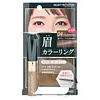What's inside
What's inside
 Key Ingredients
Key Ingredients

 Benefits
Benefits

No benefits
 Concerns
Concerns

 Ingredients Side-by-side
Ingredients Side-by-side

Propylene Glycol
HumectantMelaleuca Alternifolia Leaf Oil
AntioxidantWater
Skin ConditioningTrisodium Phosphate
BufferingPotassium Hydroxide
BufferingMica
Cosmetic ColorantAcrylates Copolymer
Ammonium Acrylates Copolymer
Methylparaben
PreservativeAluminum Triphosphate
AbsorbentCI 77492
Cosmetic ColorantTitanium Dioxide
Cosmetic ColorantSodium Dehydroacetate
PreservativePhenoxyethanol
PreservativePanthenol
Skin ConditioningTriphenyl Phosphate
Methacryloylethyl Phosphate
Trilinoleic Acid
EmollientSea Water
HumectantPropylparaben
PreservativeDehydroacetic Acid
PreservativePropylene Glycol, Melaleuca Alternifolia Leaf Oil, Water, Trisodium Phosphate, Potassium Hydroxide, Mica, Acrylates Copolymer, Ammonium Acrylates Copolymer, Methylparaben, Aluminum Triphosphate, CI 77492, Titanium Dioxide, Sodium Dehydroacetate, Phenoxyethanol, Panthenol, Triphenyl Phosphate, Methacryloylethyl Phosphate, Trilinoleic Acid, Sea Water, Propylparaben, Dehydroacetic Acid
Isododecane
EmollientTrimethylsiloxysilicate
EmollientCeresin
Emulsion StabilisingTitanium Dioxide
Cosmetic ColorantTalc
AbrasiveDisteardimonium Hectorite
StabilisingMicrocrystalline Wax
Emulsion StabilisingDextrin Palmitate
EmulsifyingCI 77492
Cosmetic ColorantPropylene Carbonate
SolventPolypropylsilsesquioxane
CI 77499
Cosmetic ColorantDextrin Palmitate/Ethylhexanoate
EmulsifyingPolyisobutene
PEG-20 Glyceryl Stearate
EmulsifyingCI 77491
Cosmetic ColorantPolymethylsilsesquioxane
Triethoxycaprylylsilane
Glyceryl Caprylate
EmollientSilica
AbrasiveIsododecane, Trimethylsiloxysilicate, Ceresin, Titanium Dioxide, Talc, Disteardimonium Hectorite, Microcrystalline Wax, Dextrin Palmitate, CI 77492, Propylene Carbonate, Polypropylsilsesquioxane, CI 77499, Dextrin Palmitate/Ethylhexanoate, Polyisobutene, PEG-20 Glyceryl Stearate, CI 77491, Polymethylsilsesquioxane, Triethoxycaprylylsilane, Glyceryl Caprylate, Silica
Ingredients Explained
These ingredients are found in both products.
Ingredients higher up in an ingredient list are typically present in a larger amount.
Ci 77492 is also hydrated iron III oxide. It's sole purpose is to give a yellow hue to products.
Iron III oxides are classified as inorganic chemicals for coloring.
Synthetically created Ci 77492 is considered safer than those naturally found. This is because the synthetically created version may contain less impurities. Iron oxides are generally non-toxic and non-allergenic.
Learn more about CI 77492Titanium dioxide is a mineral UV filter widely used in sunscreens and cosmetics.
It is one of only two UV filters officially classified as “mineral” by regulatory agencies, the other being zinc oxide.
Titanium dioxide provides broad-spectrum protection mostly in the UVB and UVAII range, with some protection in the UVAI range.
While its UVA protection isn’t as strong as zinc oxide’s, the difference is minor.
A common myth is that mineral UV filters reflect UV light. However, modern research shows titanium dioxide absorbs UV radiation like chemical filters (~95% absorption & 5% reflection).
Thanks to its non-irritating nature, titanium dioxide is suitable for sensitive, acne-prone, or redness-prone skin. It is unlikely to cause "eye sting" like other sunscreen ingredients.
A major drawback of this ingredient is its white cast and thick texture. This is why mineral sunscreens often leave a white cast and are less cosmetically elegant than chemical/hybrid sunscreens.
To improve white cast and spreadability, micronized or nano-sized titanium dioxide is often used.
There are ongoing concerns surrounding nano-titanium oxide's impact on marine ecosystems.
There is no conclusive evidence that any form of titanium oxide (or any other sunscreen ingredients) will cause harm to marine ecosystems or coral reefs. The science is still developing but many consumers are keeping a close eye on this issue.
Please note, many destinations have reef-safety sunscreen rules. For instance, the U.S. Virgin Islands advises all visitors to use non-nano mineral sunscreens.
Nano mineral sunscreens once raised safety concerns about absorption into skin.
Extensive research has shown that they do not penetrate healthy or damaged skin; they remain safely on the surface and the top layer of dead skin (stratum corneum).
You'll likely find titanium dioxide bundled with alumina, silica, or dimethicone. These ingredients help make titanium dioxide highly photostable; this prevents it from interacting with other formula components under UV light.
Learn more about Titanium Dioxide